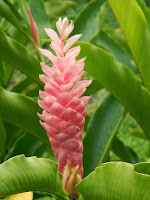Whining is not appropriate in the Marquesas.
Jacques Brel
 |
| "Gémir n'est pas de mise" aux Marquises |
 |
| Welcome (Bienvenue) to Hiva-Oa |
 |
| Anchorage with Mount Temetiu in the background |
As with so many other islands, its most treasured crop, sandalwood, was nearly decimated in 1820 when whalers would trade the wood for guns and alcohol while, of course, bringing diseases unknown to the locals, decimating the population as well. Add a little Catholicism to the mix and you have same song, next verse. Some say there used to be 100,000 Marquesans others put that figure at 50,000. There are only around 10,000 today. Locals are trying to reforest the island with sandalwood. Since 1976, they have also planted pines from the Caribbean Islands to supply construction material.
 |
| Anchorage from road to Atuona |
Beautiful Local Flora
Visiting a small artist's coop/shop, I speak with a lady whose paintings are inspired by Gauguin's work. I hesitate to speak about him for I had read that many locals despise him for he was thought to be a pedophile coming here only to take advantage of kids on the island. Since her work was inspired by him I asked her about his reputation with the locals and she kind of smiled saying that in the late 1800's girls would routinely be married by their 13th birthday and she didn't feel that way about him. Who is to know? I will still be mindful when speaking of Gauguin with the locals but it's nice to see the animosity I expected is not entirely there. It's a little sad that the island is best known for two foreigners who came to spend their last years here: Gauguin and Brel, rather than true Marquesans.
Gauguin came in 1901 from Tahiti, in the third stage of syphilis which was then supposedly no longer contagious. The church officials of the time offered him a couple of 14 year old girls to help him around the house. He had kids with one of them and she had 6 descendants, some still on the island. He died shortly after, 1903. We visited his grave in the nearby cemetery overlooking the bay. When he came here, locals had to get permission from the gendarme to purchase alcohol but Gauguin didn't. He fought to have that changed so all would be equal (not sure that was a good thing in the long run for alcoholism is a problem here). He was also known to fight the Catholics. Marquesans are increasingly getting back the traditions the Catholics have taken away from them (even though 85% are Catholics today). They now have a festival, every four years in December, with people from all the surrounding islands (Easter Island, Tuomatus, Gambier, etc) to share their various cultural heritages. Next time is in December 2015, then 2019....
Brel came in 1975 from Nuku Hiva where he had become too well known. He visited here for 3 days and loved that no one recognized him so he sold his sailboat and purchased a small aircraft instead. With that aircraft he would bring mail and freight back to the island on a regular basis, helping some locals travel (room permitting) to and fro as well.
Pierre fleurie - flowery stone
Another lady whose husband is a stone carver explains that there is a type of stone called "pierre fleurie" or "flowery stone" (phonolite with garnet) that is found only here. It comes in green (reminiscent of a darker jade), brown, black or yellow. Local artists work with bamboo, rosewoods, several other types of woods, stones, textiles, gourds, pearls, coral, etc. Our agent's (the person helping us with the paperwork involved to enter this country) husband is originally from Bordeaux. He is a woodworker who now makes guitars with the local woods. Each guitar takes him one month to build!
Being owned by the French, the cuisine is influenced by that country. You can find baguettes, croissants, pains au chocolat, beignets, etc… There is also a little Asian influence for you can find Gyoza dumplings and rice.
We were surprised by how few shorebirds the island hosts. There are no white masses of guano atop the rocks around the island. It feels a little foreign compared to the US or Mexico. A few gold or red hummingbirds flutter around. While the island is mostly covered with roosters and chickens reminding us of Mexico, it is mostly devoid of dogs and cats. The locals say the roosters help keep the population of millipedes down. The island doesn't have snakes or other dangerous critters.
French Polynesia and Marquesas flags
I hike up the hill to have a look around and see our anchorage from a different perspective. In the late afternoon heat, a quick shower comes around to cool things down. I am barefoot on the concrete road, the rain barely cooling off the built-in heat of the day. It's amazing how quickly one is alone on this island when not going towards the main town.
The island is quiet in another unusual way. At 14 all kids go to school in Papeete (Tahiti) - there are NO teenagers around. It makes for a very different type of energy (or non-energy for that matter)… They fly back and forth, quite an expensive endeavor.
The island is very clean and mostly lacking trash unlike Mexico. The cemetery is all white very much unlike Mexico where pantheons (cemeteries) are really colorful. It neither feels nor acts like a third world country.
More to follow as we go on a tour of the island with a guide…













No comments:
Post a Comment
We are always happy to hear from you but at times it may take a while to get a reply - all depends if we have access to the internet.